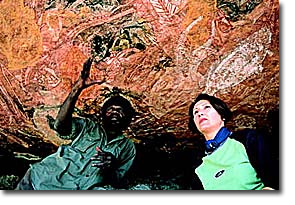KAKADU
World Heritage-listed Kakadu National Park is a place of rugged escarpments, lush wetlands and cascading waterfalls covering over 19,000 square kilometres. Kakadu is Australia's largest national park, and can be entered either from Darwin on the Arnhem Highway or via Pine Creek on the Kakadu Highway.

The flora and fauna found in Kakadu National Park is diverse, with pockets of rainforest, paperbarks, pandanus and cycads, and wetlands dotted with lotus lilies. Some of Kakadu’s amazing wildlife includes crocodiles, barramundi, and birds such as magpie geese, brolgas, jabirus and white-bellied sea eagles. Around 1000 different plant species, a quarter of all Australian freshwater fish species, and over one third of Australian bird species can be found in the Park.
Kakadu National Park is managed jointly by Parks Australia, an Australian government body, and the Park’s traditional Aboriginal owners. A number of Aboriginal clans reside within the Park, and have for some 50,000 years. Kakadu is home to one of the largest concentrations of Aboriginal rock art in the world. Natural galleries of these ancient paintings can be seen at sites like Ubirr and Nourlangie Rock.
Other spectacular landmarks include Jim Jim Falls, Twin Falls, Maguk/Barramundie Gorge, Jarrangbarnmi/Koolpin Gorge and Gunlom, which means ‘waterfall creek’. Kakadu National Park also contains several established walking tracks and camp grounds. At the centre of the Park is the small mining township of Jabiru, which offers a range of services and accommodation and serves as a touring centre for the wetlands of the nearby Mary River National Park, home to millions of birds and plentiful barramundi.
Another settlement, Cooinda, also offers accommodation, and is located on the banks of Yellow Water, a billabong teeming with migratory birds, saltwater crocodiles and other wildlife. Cruises on Yellow Water depart daily. A visit to Kakadu is best started at the Bowali Culural Centre near Jabiru or the Warradjan Aboriginal Cultural Centre near Cooinda.
Arnhem Land is made up of 91,000 square kilometres of unspoiled wilderness bounded by Kakadu National Park, the Arafura Sea and the Gulf of Carpentaria. Travellers wanting to explore Arnhem Land must obtain a permit in advance from the Northern Land Council. Alternatively, many organised tours visit Arnhem Land, and in these cases a permit is usually organised by the tour operator.

Many of Arnhem Land’s traditional Aboriginal owners live within the region, supporting a rich culture, producing unique art and crafts. The town of Maningrida, on the north coast of Arnhem Land, is famous for its indigenous art. Oenpelli, one of the first stops east of Kakadu National Park, is an Aboriginal community where indigenous artists gather at the Injalak Art and Craft Centre. Here, travellers can watch as traditional bark paintings, didjeridus, and other crafts are made.

This diverse landscape is characterised by wild coastlines, towering escarpments, savannah woodlands and flood plains teeming with wildlife. Amazing natural landscapes, like Mt Borradaile, situated in the north-west corner of Arnhem Land, support a multitude of ecosystems. The Coburg Peninsula is accessed via charter flight, boat or four-wheel-drive. This secluded peninsula is home to the Garig Gunak Barlu National Park, which provides a habitat for abundant wildlife, including crocodiles, dugongs, nesting turtles and migratory birds.
Arnhem Land boasts many excellent fishing destinations. Travellers can enjoy some of the world’s best tropical fishing in the mangroves, wetlands, rivers, and reefs of Arnhem Land, targeting barramundi, mangrove jack, coral trout and other sportfish.










